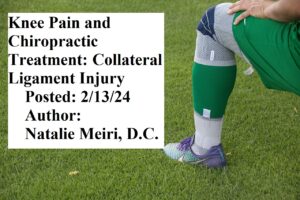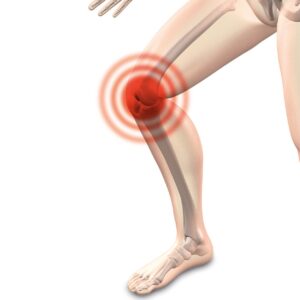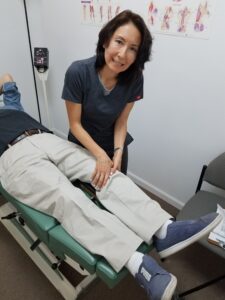
If you have knee pain from a collateral ligament injury, Chiropractic can provide relief! This post is about Knee Pain and Chiropractic Treatment: Collateral Ligament Injury.
Anatomy of the knee: Femur (thigh bone), Tibia (shin bone), Fibula (thin, outer long bone of the leg), and the Patella (kneecap)
There are three “articulations” (joint or juncture between bones or cartilages) at the knee: the tibiofemoral, patellofemoral, and tibiofibular articulations. However, only the tibiofemoral and patellofemoral articulations participate in knee joint activity. The tibiofibular articulation/joint does not actually contribute to the actions of the knee. Instead, it is part of the ankle joint complex moving the ankle in all the various ranges of motion. However, dysfunctional processes in the proximal tibiofibular articulation/joint can affect other knee functions and can be a source of knee pain.
So the tibiofemoral and tibiofibular are synovial articulations. These are freely movable joints. And the bony surfaces are coated with hyaline cartilage. It is unified by a fibrous articular capsule. However, the third articulation, patellofemoral, is a functional joint (non-synovial joint).
More Anatomy of the Knee
First, the knee is supported by the joint capsule, its cartilage “thickenings”, and the collateral-ligamentous system. And the collateral ligaments (band of tissue that connects a bone to another bone) are located on either side of your knee outside your knee joint.
Second, internally the knee is stabilized and the control of rotation is provided by the meniscocruciate system. There are two C-shaped cartilage like structures, each one called a meniscus. The menisci aid in shock absorption and help govern rotational movement at the knee.
Third, the cruciates, capsule, and collateral ligaments connect the femur to the tibia. The cruciates are a pair of ligaments that cross each other in the knee, connecting the tibia and the femur. The Anterior Cruciate Ligament (ACL) is smaller (size of the little finger) than the Posterior Cruciate Ligament. It’s usually more readily injured than the Posterior Cruciate Ligament (PCL) (size of the thumb). The cruciates allow tension to develop through most ranges of motion.

Cause of Pain in the Knee due to Collateral Ligament Injuries
Firstly, the knee is affected by a variety of conditions. However, a traumatic event is by far the most common. The MCL (medial collateral ligament) is the most commonly injured knee ligament, and LCL (lateral collateral ligament) injuries are usually associated with more severe knee injuries. So injuries to the collateral ligaments usually require some type of traumatic force.
Secondly, in external rotation of the knee, your toes go outward and your heel goes inward. A frequent trauma occurs with a twisting external rotation movement of the knee while flexed (bent). Furthermore, a valgus/abduction (hit from outside of knee) blow to the knee is another common mechanism for MCL injuries. In contrast, a LCL injury may occur with a varus/adduction (hit from inside of knee) blow to the knee.
Thirdly, the knee joint is innervated (supplied) by spinal nerve segments L3–S1. Therefore, in cases of pain of nontraumatic onset, problems elsewhere in (e.g. segments L3–S1) must be ruled out. Lastly, the lumbar spine, hip, and foot are possible sources of referred pain to the knee as well.
Fourthly, chronic strain through valgus-loading of the knee (e.g., pronation) can cause nontraumatic injury. Ultimately, this repetitive stress injury can lead to a collateral ligament sprain.
Finally, your doctor should take all the above into account when examining, diagnosing and then treating your knee. Of course, you will require imaging such as an x-ray or/and M.R.I. to properly diagnose your knee condition.
Collateral Ligament Injury Grades
With first-degree tears, you will frequently not have any history of trauma. You may report more mild to moderate pain at the knee. And overuse activity may have brought on this knee sprain.
When the tear is second or third degree, there is usually a traumatic incident as described above. You will have sharp knee pain with associated swelling at the time of injury.

Knee Pain and Chiropractic Treatment: Collateral Ligament Injury
First, chiropractic manipulative therapy is rendered to the knee and associated spine and extremity (limb) joints.
Second, manipulation of muscle contractures with soft tissue techniques is utilized. Some Techniques include gentle PNF/PIR (e.g. post isometric relaxation) and/or myofascial release techniques.
Finally, Therapeutic exercises for rehabilitation/ strengthening are prescribed.
Getting regular chiropractic treatment at a chiropractic center in West Palm Beach can help naturally relieve the pain and dysfunction of the knee. Chiropractic is a holistic and natural way to not only treat existing conditions, but to keep your body in its best working condition.
Contact Meiri Chiropractic today at 561-253-8984 to make an appointment on Knee Pain and Chiropractic Treatment: Collateral Ligament Injury or/and other ailments.